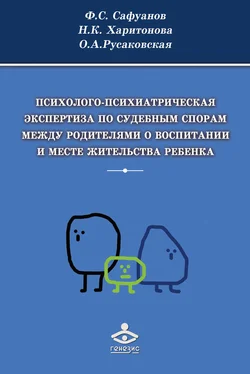Lamb, M.E., ed. The role of the father in child development. – N.Y.: Wiley, 1981.
Laumann-Billings L., Emery R.E. Distress among young adults in divorced families // Journal of family Psychology. – 2000. – Vol. 14. – P. 671–687.
Long N., Forehand R., Fauber R., Brody G. Self-perceived and independently observed competence of young adolescents as a function of parental marital conflict and recent divorce // Journal of Abnormal Child Psychology. – 1987. – Vol. 15. – P. 15–27.
Maccoby E.E., Mnookin R.H. Dividing the child: Social and legal dilemmas of custody. – Cambridge, MA: Harvard University Press, 1992.
Mason M.A. From fathers property to children's rights: The history of child custody in the United States. – N.Y.: Columbia University Press, 1994.
Mathis R. Couples from Hell: Undifferentiated Spouses in Divorce Mediation // Mediation Quarterly. – 1998. – Vol.16. – P. 37–49.
Mclsaac, H., Finn, C. Parents Beyond Conflict: A Cognitive Restructuring Model for High-Conflict Families in Divorce // Family and Conciliation Courts Review. – 1999. – Vol. 37. – № 1. – P. 74–82.
McLanahan S.S. Father absence and children's welfare // Coping with divorce, single parenting and remarriage: A risk and resiliency perspective / E.M. Hetherington (ed.). – Mahwah, NJ: Lawrence Erlbaum, 1999. – P. 117–146.
Mott E, Kowaleski-Jones L., Menaghan E. Parental absence and child behavior: Does a child's gender make a difference? // Journal of Marriage and the Family. – 1997. – Vol. 59. – P. 103–118.
Nurcombe В., Partlett F. Child Mental Health and the Law. – N.Y.: Free Press, 1994.
Pearson J., Ihoennes N. Will this divorced woman receive child support? // The Judges Journal. – Winter, 1986.
Pearson J., Ihoennes N. Divorce mediation research results // Divorce mediation: Theory and practice / J. Folberg, A. Milne (eds.). – N.Y: Guilford Press, 1988. – P. 29–52.
Pearson J. Ihoennes N. Mediating and litigating custody disputes: A longitudinal evaluation // Family Law Quarterly. – 1984 – Vol. 17. – № 4 – P. 497–524.
Peterson J., Zill N. Marital disruption, parent-child relationships and behavior problems in children // Journal of Marriage and the Family. – 1986. – Vol. 48. – P. 295–307.
Herman S.P. et.al. Practice Parameters for Child Custody Evaluation // American Academy of Child and Adolescent Psychiatry. – 1997. URL: http://www.aacap.org-galleries-PracticeParameters-Custody.pdf.url
Roserby V., Johnston J.R. Children of Armageddon: Common developmental threats in high conflict divorcing families // Child and Adolescent Psychiatry Clinics of North America. – 1998. – Vol. 7. – № 2. – P. 295–309.
Rutter M. Clinical implications of attachment concepts: retrospect and prospect // Journal of Child Clinical Psychology. – 1995. – Vol. 36. – P. 549–571.
Schowalter J.E. Views on the role of the child's preference in custody litigation // Conn Bar J. – 1979. – Vol. 53. – P. 298–300.
Simons R.L. Understanding differences between divorced and intact families: Stress, interaction and child outcome – Thousand Oaks, CA: Sage, 1996.
Simons R.L., Lin K., Gordon L.C. Socialization in the Family of Origin and Male Dating Violence: A Prospective Study // Journal of Marriage and the Family. – 1998. – Vol. 60. – № 2. – P. 467–478.
Snyder H.N., Sickmund M. Challenging the Myths. 1999 National Report Series // Juvenile Justice Bulletin. Office of Juvenile Justice and Delinquency Prevention. – 2000. – Feb. URL: www.ncjrs.org/html/ojjdp/ jjbul2000_02_2/contents.html (2000, May 25)
Spillane-Grieco E. Cognitive-behavioral family therapy: With a family in high-conflict divorce: a case study// Clinical Social Work Journal. – 2000. – Vol. 28.– P. 105–119.
Steinman S.B., Zemmelman S.E., Knoblauch T.M., A Study of Parents Who Sought Joint Custody Following Divorce // Journal of the American Academy of Child Psychiatry. – 1985. – 24(5).
SteinbergL, Lamborn S, DarlingN, Mounts N, Dornbusch S. Over-time changes in adjustment and competence among adolescents from authoritative, authoritarian, indulgent, and neglectful families // Child Development. – 1994. – Vol. 65. – P. 754–770.
SteinbergL. Beyond the Classroom: Why School Reform Has Failed and What Parents Need To Do. – N.Y., 1996.
Stewart R. The Early Identification and Streaming of Cases of High-Conflict Separation and Divorce: A Review. Ottawa: Department of Justice Canada (2001-FCY-7E/7F)
Sun Y. Family environment and adolescents' well-being before and after parents' marital disruption: A longitudinal analysis // Journal of Marriage and Family. – 2001. – Vol. 63. – P. 697–713.
Sun Y, Li Y Children's well-being during parents' marital disruption process: A pooled time-series analysis // Journal of Marriage and Family. – 2002. – Vol. 64. – P. 472–488.
Sun Y, Li Y Marital disruption, parental investment, and children's academic achievement // Journal of family Issues. – 2001. – Vol. 22. – P. 27–62.
The American Psychiatric Association, Child custody consultation: Report on the Task Force on Clinical Assessment in Child Custody // American Psychiatric As'n rev. ed. – Washington, D.C., 1988.
Thomas A.M., Forehand R. The relationship between parental depressive mood and early adolescent functioning // Journal of Family Psychology. – 1991. —Vol. 4.– 260–271.
Thompson R. Fathers and the child's «best interests»: Judicial decision making in custody disputes // The fathers role: Applied perspectives / M.E. Lamb (ed.). – N.Y.: Wiley 1986. – P. 61—102.
TschannJ., Johnston J., Kline M., Wallerstein J. Conflict, loss, change and parent-child relationships: Predicting children's adjustment during divorce // Journal of Divorce. – 1990. – Vol. 13. – № 4. – P. 1—22.
Twaite J, Luchow A.K. Custodial arrangements and parental conflict following divorce: The impact of children's adjustment // Journal of Psychiatry and Law. – 1996. – Vol. 24. – P. 58.
Uniform Marriage and Divorce Act. – 1970.
Vandawater E., LansfordJ. Influences of family structure and parental conflict on children's well-being // Family relations. – 1998. – Vol. 47. – P. 323–330.
Vestal A. Mediation and parental alienation syndrome: considerations for an intervention model // Family and Conciliation Courts Review. – 1999. – Vol. 37 – P. 487–503.
Wallerstein J.S. Children of divorce: Report of a ten-year follow-up of early latency age children // American J. of Orthopsychiatry. – 1987. – Vol. 57.– P. 199–211.
Wallerstein J.S. The long-term effects of divorce on children: A review// Journal of the American Academy of Child and Adolescent Psychiatry. – 1991. – Vol. 30. – P. 349–360.
Wallerstein J.S., Corbin S. The child and the vicissitudes of divorce // Child and Adolescent Psychiatry: A Comprehensive Textbook. 3rd ed. – Lippincott, Philadelphia: Williams and Wilkins, 2002. – P. 275—1285.
Wallerstein J.S., Lewis J.M., Blakeslee S. The unexpected legacy of divorce. – N.Y.: Hyperion, 2000.
Wallerstein, J.S., Kelly, J.B. Surviving the breakup: How children and parents cope with divorce. – N.Y.: Basic Books, 1980.
Warshak R.A., Santrock J.W. The impact of divorce in father-custody and mother-custody homes: The child's perspective // Children and Divorce / L.A. Kurdek (ed.). – SanFrancisco: Jossey-Bass, 1983.
Читать дальше
Конец ознакомительного отрывка
Купить книгу





![Симона Дэвис - Монтессори для малышей [Полное руководство по воспитанию любознательного и ответственного ребенка] [litres]](/books/402222/simona-devis-montessori-dlya-malyshej-polnoe-rukovo-thumb.webp)






